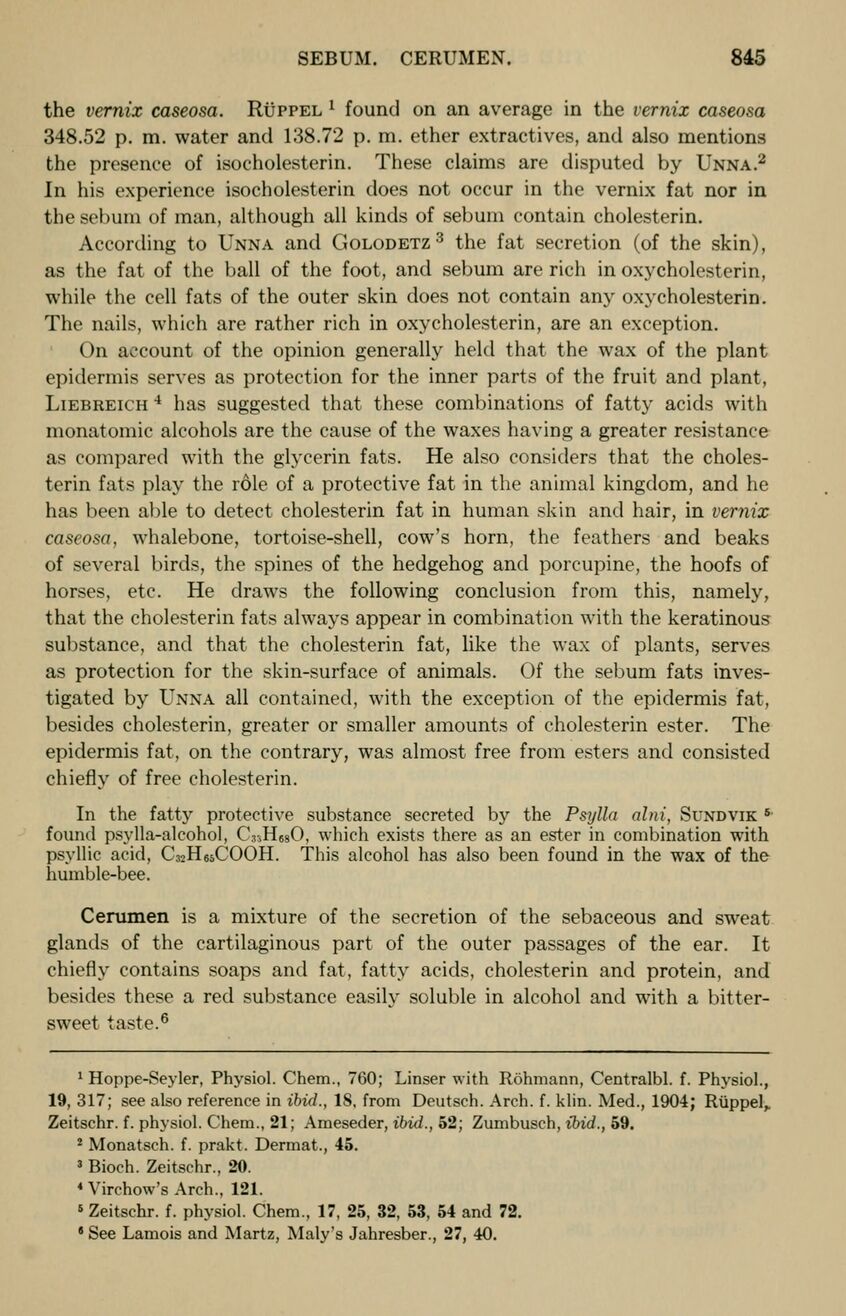
Full resolution (JPEG) - On this page / på denna sida - XV. The Skin and its Secretions

<< prev. page << föreg. sida << >> nästa sida >> next page >>
Below is the raw OCR text
from the above scanned image.
Do you see an error? Proofread the page now!
Här nedan syns maskintolkade texten från faksimilbilden ovan.
Ser du något fel? Korrekturläs sidan nu!
This page has never been proofread. / Denna sida har aldrig korrekturlästs.
SEBUM. CERUMEN. 845
the verniz caseosa. Ruppel l
found on an average in the vernix caseosa
348.52 p. m. water and 138.72 p. m. ether extractives, and also mentions
the presence of isocholesterin. These claims are disputed by Unna.2
In his experience isocholesterin does not occur in the vernix fat nor in
the sebum of man, although all kinds of sebum contain cholesterin.
According to Unna and Golodetz 3 the fat secretion (of the skin),
as the fat of the ball of the foot, and sebum are rich in oxycholesterin,
while the cell fats of the outer skin does not contain any oxycholesterin.
The nails, which are rather rich in oxycholesterin, are an exception.
On account of the opinion generally held that the wax of the plant
epidermis serves as protection for the inner parts of the fruit and plant,
Liebreich 4
has suggested that these combinations of fatty acids with
monatomic alcohols are the cause of the waxes having a greater resistance
as compared with the glycerin fats. He also considers that the choles-
terin fats play the role of a protective fat in the animal kingdom, and he
has been able to detect cholesterin fat in human skin and hair, in vernix
caseosa, whalebone, tortoise-shell, cow’s horn, the feathers and beaks
of several birds, the spines of the hedgehog and porcupine, the hoofs of
horses, etc. He draws the following conclusion from this, namely,
that the cholesterin fats always appear in combination with the keratinous
substance, and that the cholesterin fat, like the wax of plants, serves
as protection for the skin-surface of animals. Of the sebum fats inves-
tigated by Unna all contained, with the exception of the epidermis fat,
besides cholesterin, greater or smaller amounts of cholesterin ester. The
epidermis fat, on the contrary, was almost free from esters and consisted
chiefly of free cholesterin.
In the fatty protective substance secreted by the Psylla altii, Sundvik 5
found psylla-alcohol, CsnHesO, which exists there as an ester in combination with
peyllic acid, C32H65COOH. This alcohol has also been found in the wax of the
humble-bee.
Cerumen is a mixture of the secretion of the sebaceous and sweat
glands of the cartilaginous part of the outer passages of the ear. It
chiefly contains soaps and fat, fatty acids, cholesterin and protein, and.
besides these a red substance easily soluble in alcohol and with a bitter-
sweet taste. 6
1
Hoppe-Seyler, Physiol. Chem., 760; Linser with Rohmann, Centralbl. f. Physiol.,
19, 317; see also reference in ibid., 18, from Deutsch. Arch. f. klin. Med., 1904; Riippel,.
Zeitschr. f. physiol. Chem., 21; Ameseder, ibid., 52; Zumbusch, ibid., 59.
2
Monatsch. f. prakt. Dermat., 45.
3
Bioch. Zeitschr., 20.
4
Virchow’s Arch., 121.
5
Zeitschr. f. physiol. Chem., 17, 25, 32, 53, 54 and 72.
• See Lamois and Martz, Maly’s Jahresber., 27, 40.
<< prev. page << föreg. sida << >> nästa sida >> next page >>